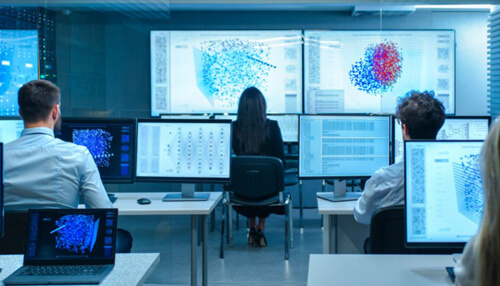Today’s technology has created a new and dynamic workplace dynamic, with employee expectations continuing to rise and businesses forced to adapt or risk losing their best talent. Working from home, telecommuting, and other remote working arrangements are now commonplace in many industries, as employees demand increased flexibility in how and where they work. With the continued growth of mobile apps, cloud computing, and several other emerging technologies, many businesses have begun making strategic changes to accommodate these new ways of working. Here are 8 ways technology is changing the modern workplace.
Cloud Computing & Data Storage
Technology is transforming the landscape of business. But the cloud is something you’ve probably heard of. Cloud computing has become an essential part of the modern workplace, with most enterprises now using some form of cloud service to store and manage data. Providers like Amazon, Microsoft, and Google have become global leaders in this space. As a result, businesses can quickly scale their cloud resources and easily integrate with other applications. The transition to cloud-based hosting has also led to an increased focus on data security, with many organizations regularly backing up their data to the cloud to ensure it is secure in the event of an incident.
Data security is now a significant concern for many businesses, with recent incidents highlighting just how vulnerable organizations can be. In light of these concerns, cloud services offer employees a convenient way to securely access essential enterprise data from virtually any device.
Remote Working
Despite the rise of flexible working arrangements, remote work is more popular than ever and continues to gain momentum. Remote work can be an ideal way for employees to create a work-life balance and avoid the daily commute. While also benefiting the employer by reducing overhead costs such as office space and utility bills.
It’s often associated with a certain level of risk, however, as employees may find it difficult to focus during quiet times. To combat this, many businesses are now embracing virtual meeting rooms and video conferencing technology to make collaboration more effective. Nevertheless, remote work doesn’t suit every situation and should be used carefully to ensure employees do not become isolated.
AI & Machine Learning
Artificial intelligence and machine learning are closely linked, with AI being the broader term used to describe a wide range of technologies. AI can be used for various functions within the workplace, with many organizations now using it to automate repetitive tasks such as analyzing data and completing administrative work.
AI is also closely linked to virtual assistants like Siri and Google Assistant, designed to help employees meet their daily workflow needs, and AI can also facilitate more advanced remote collaboration and communication tools, such as live language translation and virtual digital assistants. Artificial intelligence is still in the early stages of adoption across the workplace, with many businesses now looking to integrate it into their operations.
Virtual Teams
The rise of telecommuting, remote work, and flexible working arrangements have also increased virtual teams, where employees regularly collaborate remotely. Virtual teams are used across a wide range of industries, including software development and engineering. Many businesses now employ a hybrid approach that mixes both virtual and in-person work environments.
Virtual teams can be highly effective in reducing costs and increasing productivity, particularly when combined with AI-powered collaboration tools. As a result, organizational leaders are increasingly being challenged to support virtual teams, find ways to increase interaction, and facilitate real-time communications between members.
Cloud Collaboration
As organizations increasingly rely on cloud-based collaboration tools, many have begun investing in the next level of technology. Modern collaboration tools leverage AI and machine learning to improve efficiency and effectiveness, from simple cloud-based file-sharing systems to high-end virtual conferencing and communications platforms.
Collaboration tools have become essential to any organization’s daily operations, with many businesses now looking to enable real-time communication across multiple platforms and devices. This includes enabling collaboration features in team communication apps, such as video conferencing and screen sharing. Collaboration tools also help to protect sensitive information by restricting access to specific users based on their role in the business.
Test Automation
Test automation is a crucial strategy for many businesses looking to maintain a high level of quality assurance in their products. These tools help QA engineers and IT teams create automated tests that can be run quickly and efficiently to determine whether a feature is working as intended. As testing has become more automated, the ability to scale testing efforts has become increasingly important, particularly for larger organizations with multiple engineering teams. This has led to the rise of cloud testing tools, allowing organizations to quickly and easily expand their testing capabilities across various devices and environments.
Test automation like TestRigor allows QA engineers to run tests automatically. This frees up valuable time, creating a faster feedback cycle that reduces business expenditure. In addition, test automation gives better insights, improves accuracy, and means software gets to market much quicker.
Employee Tracking & Scheduling Apps
With businesses increasingly looking to maximize their time and ensure employees are working effectively, tracking apps and scheduling tools have become a popular option. These types of software can help employees manage their workday, identify weak areas, and even find new ways to increase productivity. This can be done by integrating existing apps and workflows and leveraging AI and machine learning to provide real-time suggestions and insights.
Employee tracking and scheduling apps are an increasingly common feature within HR software, helping organizations keep track of and manage their workforce.
Mobility
The rise of mobile work has led to many organizations seeking to provide a consistent experience across all devices. Unfortunately, this continues to be a challenge for many businesses, particularly those dealing with legacy systems.
With the growth of cloud strategies, many organizations are looking to provide a consistent platform supporting core applications and workloads. Regardless of location. This is helping to improve collaboration across teams. And is also enabling new ways of working that were impossible in the past.



